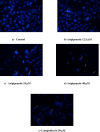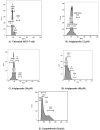Antipsychotics drug aripiprazole as a lead against breast cancer cell line (MCF-7) in vitro
- PMID: 32746451
- PMCID: PMC7398703
- DOI: 10.1371/journal.pone.0235676
Antipsychotics drug aripiprazole as a lead against breast cancer cell line (MCF-7) in vitro
Abstract
Breast cancer is the second leading cause of death among women globally. The existing treatment options for breast cancer are largely associated with severe toxicities, and lower efficacies. Therefore, there is an urgent need for the development of non-toxic effective drugs against breast cancer. For this purpose, drug repositioning strategy was used to evaluate the anti-cancer potential of a library of heterocyclic drugs. The major advantage of drug repurposing is that the pharmacokinetic, pharmacodynamic, and toxicity profiles of drugs are well documented. In the current study, we screened 97 drugs of different chemical classes, and among them aripiprazole, an antipsychotic drug, was found to be sufficiently active against breast cancer cell line MCF-7. Aripiprazole showed a cytotoxicity (IC50 = 12.1 ± 0.40 μM) to MCF-7 cells, comparable to the standard anticancer drug doxorubicin (IC50 = 1.25 ± 0.34 μM). Aripiprazole was also found to be active against other cancer cell lines, including MDA-MB-231 (IC50 = 19.83 ± 0.27 μM), AU565 (IC50 = 18.02 ± 0.44 μM), and BT-474 (IC50 = 36.42 ± 0.12 μM). Aripiprazole significantly inhibited the cell cycle progression at subG0G1 phase, and enhanced apoptosis in MCF-7 breast cancer cells. The drug was also able to significantly increase the nuclear condensation, and modulated the expression of certain genes involved in breast cancer, such as caspases 3, and 9, BAK-1, C-MYC, BCL2L1, BCL-10, and BCL-2. Further studies are needed to explore the effect of aripiprazole on intrinsic and extrinsic pathways of apoptosis in cancer cells.
Conflict of interest statement
The authors have declared that no competing interests exist.
Figures








References
-
- Breast Cancer Facts and Figures 2017–2018. Atlanta: American Cancer Society, Inc, 2017.
-
- Chen X. P., and Du G. H. Target validation: A door to drug discovery. Drug Discov. Ther. 2007; 1(1): 23–29. - PubMed
Publication types
MeSH terms
Substances
LinkOut - more resources
Full Text Sources
Other Literature Sources
Medical
Research Materials
Miscellaneous

